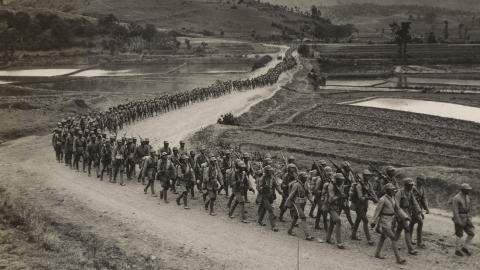Singapore and Hong Kong
The worst disaster and largest capitulation in British history.
Churchill on the fall of Singapore
December 1941 was a black month for the Allies. Following the attack on Pearl Harbour on 7 December, the seemingly unstoppable Japanese steamed their way through the Pacific and South East Asia, attacking the islands of Wake and Guam, the Philippines, Malaysia, Thailand and Burma. For Britain, the most severe material, strategic and psychological blow came with the loss of two of the 'jewels' in its imperial crown: Hong Kong and Singapore.
Just eight hours after the bombing of Pearl Harbor, 52,000 Japanese troops attacked Hong Kong. British, Canadian and Indian forces, commanded by General Maltby and supported by the Hong Kong Volunteer Defence Force, were outnumbered three to one. On the first day of the battle, the Japanese wreaked destruction upon RAF aircraft, achieving immediate air supremacy. On 10 December, they breached the recently constructed defences of Gin Drinker's Line, causing the evacuation of Kowloon and forcing Maltby's forces to retreat onto Hong Kong Island. On Christmas Day, following a week of bombardment and fierce fighting, the beleaguered Allied forces surrendered. It was the first time in history that a British crown colony had surrendered to an invading force. It became known as 'Black Christmas'.
Yet the worst blow to British imperial pride was still to come. Singapore, situated at the end of the Malayan Peninsula, was known as 'the Gibraltar of the East', and was a powerful symbol of British power in Asia.
When the Japanese arrived in February 1942, Singapore's defenders were woefully underprepared. The head of the British Army in Malaysia, General Arthur Percival, had repeatedly delayed the reinforcement of Singapore's defences. He was convinced that no army would be capable of crossing the dense jungle which protected the colony in the north. He also saw the construction of defences as dangerous to civilian and military morale. To make matters worse, the two biggest British warships in the Far East, Repulse and Prince of Wales, had been sunk by Japanese air attack on 10 December 1941, which destroyed any hope for the naval defence of Singapore.
In the ensuing battle, Japanese forces were commanded by General Tomuzuki Yamashita, who became known as the 'Tiger of Malaysia'. His troops had essentially entered 'by the back door', crossing Thailand and moving down the east coast of Malaya. Japanese forces began landing on Singapore Island on 8 February. In some areas there was fierce resistance, but thanks to Japanese air cover, and the poor preparations and deployment of Commonwealth troops, the Japanese soon made critical inroads into the defences. General Percival surrendered the island's garrison after 7 days of fighting. It was the largest surrender of British-led troops in history. 80,000 British, Australian and Indian soldiers became prisoners of war. The defenders lost 138,000 men in the battle; the invaders 10,000.
For Churchill, the fall of Singapore was the 'worst disaster in British history'. In the mentality of the time, the easy defeat of the 'white man' by Asiatic forces represented a huge loss of face for the British. Many historians argue that the defeats fuelled the confidence and strength of the post-war anti-British movements. Both Hong Kong and Singapore were occupied by the Japanese until the end of the war.
Did you know?
40,000 soldiers of the Indian Army were taken prisoner at Singapore. As many as three-quarters may have volunteered to fight in the Indian National Army, an anti-British force seeking independence for India. It fought (with little success) alongside the Japanese Army in Burma, and although some of its members were tried for treason after the war, they became popular heroes in India for their stand against British rule.
















